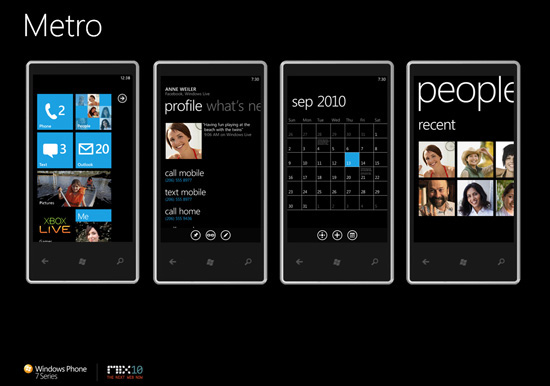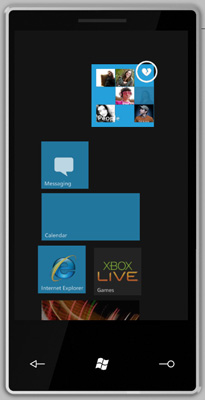Windows Phone 7: The AnandTech Guide
by Brian Klug on March 21, 2010 12:00 AM EST- Posted in
- Smartphones
- Windows Phone 7
- Mobile
Recapitulation
Microsoft MIX 2010 has drawn to a close, and with it comes our concluding wrap-up of everything that there is to discuss about Windows Phone 7 Series (henceforth WP7S).
Let's start at the beginning - WP7S does away completely with everything Windows Mobile. That means Windows Mobile applications won't run on WP7S, hardware running Windows Mobile won't run WP7S (including HTC's HD2), and Windows Mobile is no longer being actively developed. Existing hardware will get support for corporate clients, and the developer tools will remain, but they won't be actively developed. Consider Windows Mobile officially banished from the Microsoft kingdom, and you get the perspective. To give you an example of just how banished Windows Mobile is, there was virtually no discussion of porting applications from Windows Mobile to WP7S - this is a completely different platform. Microsoft wants developers to forget about Windows Mobile and immediately start thinking WP7S. The sense of urgency is because Windows Phone 7 Series will ship before the end of the year ("Holiday 2010").
Microsoft has tossed out the Windows CE-derived, aging UI of Windows Mobile. In its place, it has created a typographically-driven "user experience" that takes taken nods from Windows Media Center, the Xbox Dashboard, Zune HD interface, and urban signage. It calls this style "metro."

Metro - "It's about content and typography"
Instead of standalone application icons, WP7S uses "tiles." In practice, these are almost the same thing, except developers can both change the icon and dominant text to notify the user at-a-glance of status changes or updates. Tiles are supposed to be animated and dynamic. Tiles then launch into sessions and pages. The user interface bleeds off the sides - Microsoft wants people to navigate right to left across a page, teasing the user with elements from neighboring sections. Tiles are rearranged on start page much the same way they are on iPhone OS - pressing and holding levitates a tile, from which point you can either delete the tile (by clicking a broken heart) or drag and rearrange.

Tiles have feelings too...
Optionally, you can launch applications from a comprehensive list view as well.
The UI can be loosely customized, but right now it boils down to four different "accent" colors - which are the tile and UI highlighting colors - and "light" or "dark" for an either black text on white, or white text on black experience. Part of this customization is to leverage the battery-saving properties of AMOLED screens which consume far less power with white text on a black background.
Next are what Microsoft is calling "hubs." These are usually double-wide tiles, and serve as sort of an application for organizing your applications. For example, instead of having a lot of standalone applications which edit or modify photos spread throughout the launcher, you can optionally also launch them through the photo hub right alongside where you view pictures. Another example would be the way apps like Last.fm can themselves be launched from within the music + video hub, right alongside your Zune collection and play history. So far, there are hubs for people, pictures, office, music + video (Zune), marketplace, and games.

Note "apps" to the right. Microsoft is hip.
What each of the hubs do is pretty self explanatory. People is where you'll find all your exchange and local contacts, Pictures is for albums and slideshows, Office includes Excel, Word, and OneNote documents, and Music + Video bundles Zune music and videos alongside other media on WP7S. Marketplace is WP7S' take on an application store, and Games has tight integration with Microsoft's cloud services, including Xbox LIVE. More on that later.
















55 Comments
View All Comments
pcfxer - Sunday, March 21, 2010 - link
Android is far easier to develop for than WM and iPhone. For my engineering project my team is developing a device for non-verbal users.pro5 - Monday, March 22, 2010 - link
Is android Java only? (I don't know) but if so that would reason enough for me not to develop for it. C# and objective C are 'bad enough' but java has always left me cold (I'm a C++ coder mainly).If it can use native C++ then great, still doesn't make up for it's other short comings. The only real advantage I see to Android is how 'open' it is, but really that's more of killer than a helper in the dev community (if money is your goal). How does the GPU compare to Winphone for example? Where is the 'standard' development target (screen size, hardware features). Stuff like iPhone and WP7 are 'easier' to develop for because you never need to 2nd guess the user's hardware config or screen size (ok 2 sizes in the case of WP7 in future)
Penti - Monday, March 22, 2010 - link
Android has the NDK so you can run native code, you don't need to run your code in dalvik. That means C and C++. Just as any other Linux based Phone OS. Such as WebOS. Of course Maemo too. Bada too of course, and of course none Linux based Symbian.The shit runs at the same hardware so what's your problem? Nobody is forcing you to develop for free. That you can release your apps without review is not a bad thing. Apps such as Firefox (Fennec) are ported to Maemo and being ported to Android. There's an Alpha for WinMo too. Something that can't be done on iPhone OS or Blackberry. Or WP7. If you only want to develop for a specific phone thats fine, but then you miss millions of other users. Even if you do android apps you don't need to support every single phone there is. Old phones won't be upgraded to newer versions of Android OS any way. And it's really the software platform that should have the focus any way.
jms102285 - Saturday, April 3, 2010 - link
Hey Anand, I sent you an E-mail regarding what the implications of Microsoft Communications Server just before the release of the WP7 is.... I haven't heard anything back yet in over a week from anyone I mailed about it.Are you guys tight-lipped about it because of NDAs or something???
CSMR - Sunday, March 21, 2010 - link
Not really (http://jkontherun.com/2009/11/23/windows-mobile-vs...">http://jkontherun.com/2009/11/23/window...droid-wi... but hopefully it will be within a year.I'm hoping that it will get full, reliable exchange support (e-mail+calendar+tasks+scheduling meetings+search server etc.).